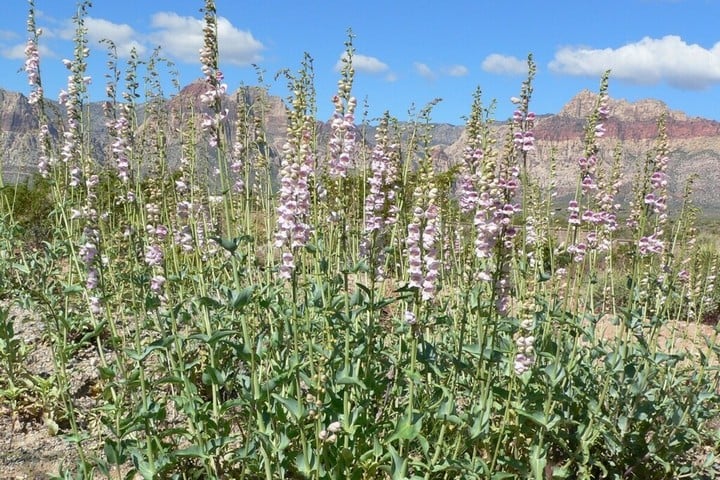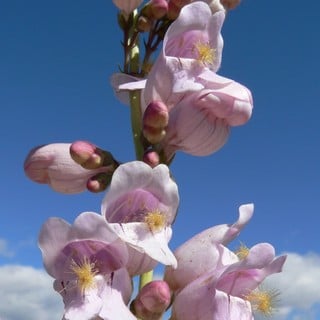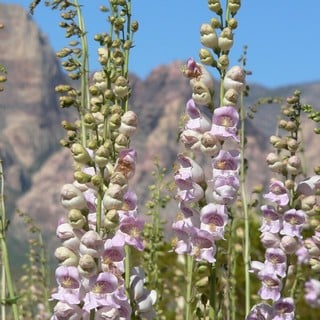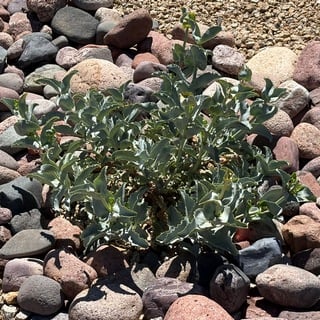Attractive blue-green rosettes and 5 foot tall flower spikes make Palmer’s penstemon a standout. This perennial has many attributes, but is not commonly grown. Here’s everything you need to know about growing this exceptional southwest desert native.

Palmer’s penstemon (Penstemon palmeri) is a native wildflower that makes a breathtaking garden perennial. It’s not as commonly grown (or sold) as the more popular native penstemons (such as Parry’s penstemon or firecracker penstemon), but it has so many wonderful qualities, it’s definitely worth seeking out.
It has leathery leaves that that form evergreen rosettes that stay attractive all year. When it blooms, it sends up 5 to 6 foot tall stalks spikes adorned with pastel flowers reminiscent of small hollyhocks.
The colors of these plants can be variable. Leaves are green, gray-green, or blue-green. Flowers are typically pastel pink or purple-pink, but can be nearly white. Unlike most other penstemons, its flowers are fragrant. Depending on your microclimate, flowers can appear anytime between March and September.
This charming native would not look out of place in an English cottage garden, yet it can take whatever the desert throws at it — full sun and temperature extremes. In its native environment, plants can survive on as little as 5″ of annual rainfall.
Palmer’s penstemon is extremely low maintenance and when grown in the garden, this plant is more likely to die from too much attention than from neglect.
The flowers attract numerous pollinators including butterflies, bees, bats, and hummingbirds. Seed eating birds eat the seeds. Plants are larval hosts for several species of moths and butterflies.
Why I Like This Plant
- Fragrant pastel flowers
- Native wildflower, easy to grow from seed
- Reseeds manageably
- Extremely low maintenance
- Supports pollinators and other wildlife
Things to Watch Out For
Resist the urge to pamper this plant. Its natural habitat includes sandy washes, roadsides, and rocky canyon floors. Giving this plant too much water, rich soil, fertilizer, or organic mulch will make it more prone to root and can shorten its lifespan.
Note that Palmer’s penstemon is a short-lived perennial, only living 4 to 5 years. However, it often reseeds, so new plants often take the place of the parent.
Penstemons are not considered poisonous to pets, but since they can accumulate selenium, it’s best to prevent pets and livestock from eating it.

Optimal Growing Conditions
If you’re thinking of adding Palmer’s penstemon to your garden, you need to find a suitable place that will keep your plants looking good and coming back year after year.
Here are the main factors to keep in mind.
Temperature
Palmer’s penstemon should be grown in USDA Hardiness Zones 5 – 11. It has no problem handling desert heat and is cold-hardy down to a frigid -30℉.
Sun Exposure
Palmer’s penstemon will grow in either full sun or part shade.
Size and Growth Rate
Palmer’s penstemon grows moderately fast. If you start plants from seed, it usually takes two years for them to bloom. The foliage forms rosettes 2 feet tall and wide, but the flower stalks add 3 feet in height, shooting up to an impressive 5 to 6 feet tall.

Unlike the more common Parry’s penstemon, which gets raggedy or completely dies back after blooming, Palmer’s penstemon’s foliage is evergreen and forms silver rosettes that remaining attractive all year.

Soil
Palmer’s penstemon naturally grows in dry, rocky soil. It performs best in the garden when planted in similar conditions. It does not do well in clay or soil high in organic content, and is prone to root rot in poorly drained soils.
Palmer’s Penstemon:
The Essentials
| Common Name | Palmer’s penstemon |
| Scientific Name | Penstemon palmeri |
| Origin | US Southwest |
| Plant Type | Evergreen perennial |
| USDA Zones | Zones 5 – 11 |
| Cold Hardy | To -30℉ |
| Flower Color | Light pink |
| Flower Season | Spring, summer |
| Mature Size | 2’ high x 2’ wide |
| Growth Rate | Moderate |
| Sun Tolerance | Full, part sun |
| Water Needs | Low |
| Pests & Diseases | Root rot if overwatered |
| Garden Friendly | No thorns, non-toxic |
| Wildlife | Attracts birds, various pollinators |
Growing Palmer’s Penstemon: Transplants vs Seeds
There are two ways to grow Palmer’s penstemon. You can buy transplants or grow from seed. Let’s take a look at both so you can decide which will work best for you.
Grow from Transplants
Palmer’s penstemon transplants can be hard to find. Your best bet will be a nursery that specializes in native plants, such as Spadefoot Nursery (Tucson) or High Country Gardens (online).
If you do decide to go with a transplant, be aware that wildflowers do not like to have their roots disturbed, so remove from the pot carefully and disturb the roots as little as possible.
Amending the soil is not recommended and mulch with gravel rather than organic mulch.
Grow From Seed
Since plants can be hard to find, growing from seed may be your only option.
Native Seeds/SEARCH is a not-for-profit organization that specializes in seeds of the desert southwest. They’ll ship seeds to you, or you can arrange to pick them up if you’re in Tucson. They carry Palmer’s penstemon seeds and a “happy hummingbird” seed mix that contains 5 species of penstemon, including Palmer’s.
Sow seeds in the fall and you’ll be rewarded with seedlings the following spring.
How to Care for Palmer’s Penstemon
This section is short since these plants really don’t need much care.
How to Water
After planting, water every few days, then gradually reduce watering. While your plant could live on rainfall alone — as it does in the wild — it will do better if it gets watered once or twice per month, either from rainfall or irrigation. If you irrigate, try to replicate your area’s normal rainfall pattern.
Should You Fertilize?
In general, native wildflowers don’t need fertilizer, since they are well-adapted to thrive in native soil. Too much fertilizer or compost can actually shorten their lifespan.
Pruning & Thinning
Palmer’s penstemon doesn’t need pruning other than cutting spent flower stalks. If you want your plant to reseed or plan to collect seeds, leave the flower stalks in place until the seed pods have dried. Then you can easily collect the seeds.
Palmer’s penstemon doesn’t like to be crowded, so if it reseeds, sometimes the best strategy is to remove older plants to give their offspring room to grow.
Plant Lover Facts
Palmer’s penstemon (Penstemon palmeri) also goes by the common names scented penstemon, Palmer’s beardtongue, scented beardtongue, and balloon flower.
It’s named after Edward Palmer, a self-taught botanist who amassed over 100,000 plant collections that still reside in prestigious institutions around the world. His documentation of plant uses of the US southwest and Mexico helped found modern ethnobotany.
Palmer’s penstemon is native to arid regions of Arizona, California, Nevada, New Mexico, and Utah, making it native to parts of the Mojave, Chihuahuan, and Sonoran Deserts. It has naturalized in Colorado, Idaho, Washington, and Wyoming.
The Navajo made a poultice of Palmer’s penstemon to treat snake bite.
Did you enjoy this article?
Sign up for our weekly newsletter
where you’ll find more great info on creating &
maintaining a beautiful, carefree desert landscape.
Author Bio
Deane Alban is the creator of Southwest Gardener. She is a science writer with a bachelor’s degree in botany from the University of South Florida. Gardening is her lifelong passion. She’s been gardening in Tucson for over 15 years.

Photo Credits
Stan Shebs, CC-BY-SA 4.0, iNaturalist.com
